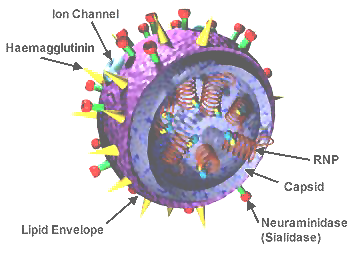Viruses and Prions
Transmission electron micrograph of shape of norovirus particles (virions). Noroviruses cause the “stomach flu” or gastroenteritis.
Content provider: CDC/Chales D. Humphrey
Image source: phil.cdc.gov
How can such simple structures be so puzzling? Compared to the multi-system complex vertebrates made up of organized cells, tissues, and organs, viruses and prions appear, at first glance, to be extremely simple particles. But, appearances are deceiving.
With seemingly very little to work with, viruses and prions cause debilitating conditions and countless deaths from diseases that cannot be cured and that science struggles to control. How can virus and prion disease effects be so destructive?
Objectives
To understand the importance of viruses and prions, you should be able to:
- Compare and contrast the structure and characteristics of different types of viruses.
- Explain why scientists have not agreed on the classification of viruses as either living or non-living.
- Describe diseases caused by different types of viruses.
- Describe the structure of a prion.
- Explain the significance of prions in causing infectious disease.
Vocabulary
- bacteriophage–a virus that attacks bacteria.
- capsid–the protein shell of a virus which encloses the genetic material.
- coronavirus–group of viruses named for the crown-like spikes on the surface of the enveloping protein coat and which cause upper respiratory tract illnesses.
- hemagglutinin–a protein on the surface of an influenza virus responsible for viral attachment to specific receptors on host cells.
- host–an organism on which another organism lives.
- lysogenic pathway–a latent, or inactive, phase of viral replication cycles; Viral genes integrate into a host chromosome and stay inactive through host cell divisions.
- lytic pathway–a phase of rapid replication in viral replication cycles.
- neuraminidase–a protein on the surface of an influenza virus that allows the virus to be released from the host cell.
- prion–small proteins that are altered gene products that cause degenerative diseases of the nervous system.
- virology–the study of viruses.
- virus–an infectious agent consisting of genetic material (DNA or RNA) and a protein coat.
Viral Structure
Viruses are made up of a protein coat, or capsid, which encloses either DNA or RNA, the genetic code for the virus. Some viruses also have a membrane (made up of lipids) that covers the capsid, but not all viruses have this membrane.
Other features of some viruses make them very well adapted to cause disease. The features are not additional components; they are part of the protein coat or viral genetic material. For example, the protein coat consists of one or more types of protein subunits arranged in various shapes, depending on the virus type. Some viral coats have spikes and tails. Spikes and tails help the virus bind to receptor sites on body cells.
Once inside the body cell, viral DNA or RNA can be replicated and thousands of new viral particles are produced. The host cell dies and the new viral particles infect more host cells.
Influenza
There are three types of influenza viruses: A, B, and C. Influenza types A and B cause human seasonal flu outbreaks almost every year. Influenza type C viruses cause only mild respiratory illness and do not cause widespread outbreaks or epidemics.
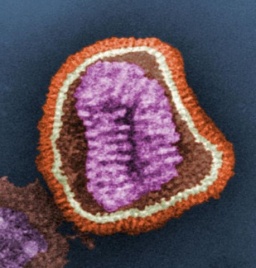
Each year more than 200,000 people are hospitalized from flu complications and about 36,000 people die from it. Above is an image of an influenza virion.
Credit: Frederick Murphy
Image source: phil.cdc.gov
Influenza Type A viruses have two surface proteins, hemagglutinin (HA) and neuraminidase (NA). Both are both embedded in the lipid membrane of the viral envelope. Hemagglutinin is responsible for the attachment of the virus to specific receptors on a host cell surface and also facilitates the fusion of the viral envelope and the cell membrane. In this way, the virus can transfer its genetic material into the host cell. Neuraminidase is a protein on the viral surface that allows the virus to be released from the host cell after replication.
There are different arrangements of both glycoproteins (hemagglutinin and neuraminidase) which result in different viral subtypes. Eighteen different hemagglutinin subtypes and 11 different neuraminidase subtypes have been identified. Different strains of these subtypes can also occur. Types of influenza are identified by their H and N configuration. For example, the H1N1 virus caused an influenza pandemic in 2009.
Influenza B viruses do not have HA and NA subtypes but are broken down into lineages. Examples are the B/Yamagata and the B/Victoria.
Influenzas are named by a naming system accepted by the World Health Organization (and followed by the U.S. CDC) that takes into account multiple identification characteristics such as host of origin, geographic origin, strain, and year, but most flus are commonly referred to by their HA and NA numbers. For example, a new H1N1 virus strain caused an influenza pandemic in 2009.
Living or Non-Living?
Whether or not viruses are living has been questioned for decades. They have genetic material, they reproduce copies, and they evolve through natural selection. These are all characteristics of living organisms. However, they lack cell structure and they cannot reproduce outside a host cell. These two are characteristics that scientists use to define life.
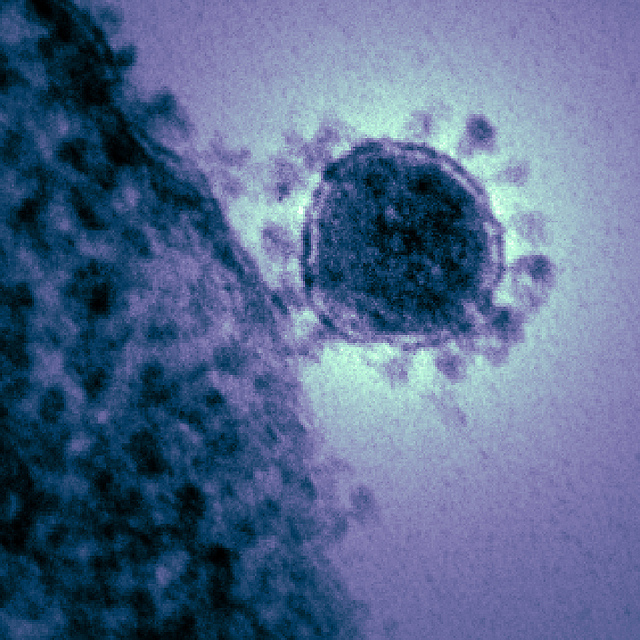
Transmission electron micrograph of the coronavirus that causes MERS (Middle East Respiratory Syndrome).
Content Provider: NIAID
Image source: phil.cdc.gov
Even though viruses have a seemingly simple structure, they come in a variety of shapes and can be quite distinctive in appearance. For example, the coronaviruses appear to have a halo surrounding the protein coat. They are helical and large for an RNA virus. The corona-like appearance results from protein spikes on the surface of the virus.
Viral Replication
Viruses multiply slightly differently according to type, but almost all cycle through the same five steps:
- Attachment: The virus attaches to a host cell. Any cell will do as long as the virus can chemically attach to specific molecular groups on the cell surface.
- Penetration: The entire virus or just its genetic material penetrates the cell and enters the cell’s cytoplasm.
- Replication and Synthesis: The viral DNA or RNA uses the host cell to produce thousands of copies of viral nucleic acids and proteins.
- Assembly: The new viral nucleic acids and proteins form new viral particles.
- Release: New viral particles are released from the cell, the cell dies, and the new particles go on to infect other healthy host cells.
These five basic steps take place in all viral replication, but different viruses accomplish them in slightly different ways. Some viruses enter the host nucleus and use the cell’s structures to replicate, but stay separate from the cell’s genetic material. Adenovirus is an example of a DNA virus that replicates in this way; influenza is an example of an RNA virus that also uses the cell’s structures to make RNA copies of itself but stays separate from the host cell’s genome.
Retroviruses replicate in a slightly different way. They are RNA viruses but the RNA is converted into DNA by a viral enzyme, reverse transcriptase. Once the RNA has been converted into the double-stranded DNA, it can become part of the host cell’s (DNA-based) genome. The virus goes on to replicate using the cell’s structures.
Human Immunodeficiency Virus (HIV), the common cold, and some forms of cancer are retroviruses. Most retroviruses are associated with causing lifelong infections.
Viruses as Pathogens
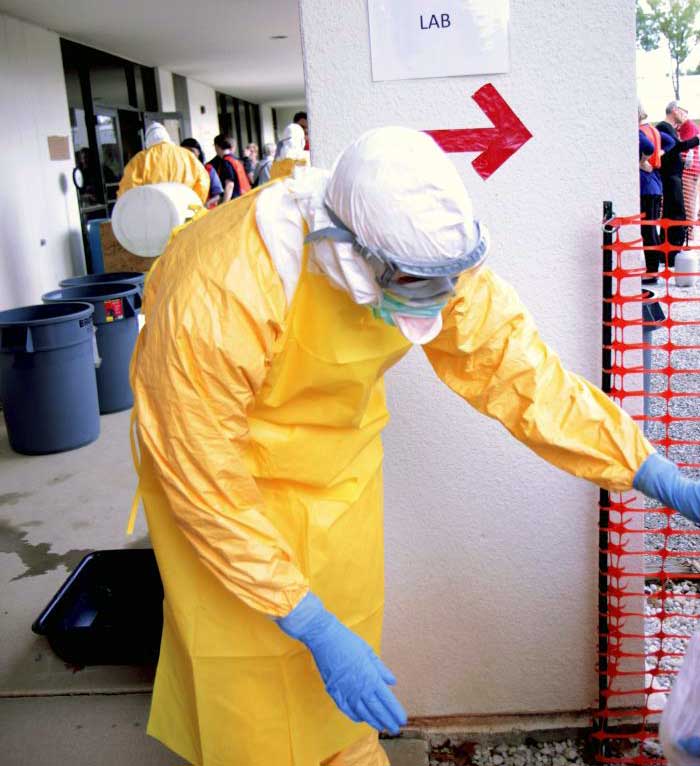
Healthcare worker observing safety protocols and protective gear when working with contagious viruses.
Image source: phil.cdc.gov
Viruses are efficient pathogens. You are probably already familiar with many of the diseases viruses cause and have probably been immunized against quite a few. Measles, mumps, chickenpox, and influenza are all viral diseases. Ebola, a deadly hemorrhagic disease, is a viral disease that was in the news for months during a recent outbreak in Africa. American healthcare workers were infected with the Ebola virus and were brought back to the U.S. to receive extended medical care. A visitor from west Africa brought the Ebola virus into the U.S. and infected healthcare workers here.
Even though high profile viral diseases make the news, it doesn’t mean that viruses are more deadly than bacteria, prions, or any other type of pathogen. Each pathogen has specific characteristics; virulence depends on the specific pathogen.
Prions
Now let’s consider a pathogen even simpler than a virus. Prions consist only of protein, yet are the cause of fatal diseases. A prion protein has multiple folding patterns and is capable of causing abnormal folding of normal proteins. The prion affects proteins found mostly in the brain. The abnormal folding leads to brain damage, neuron loss, and neurodegenerative disorders. All prion diseases are fatal.
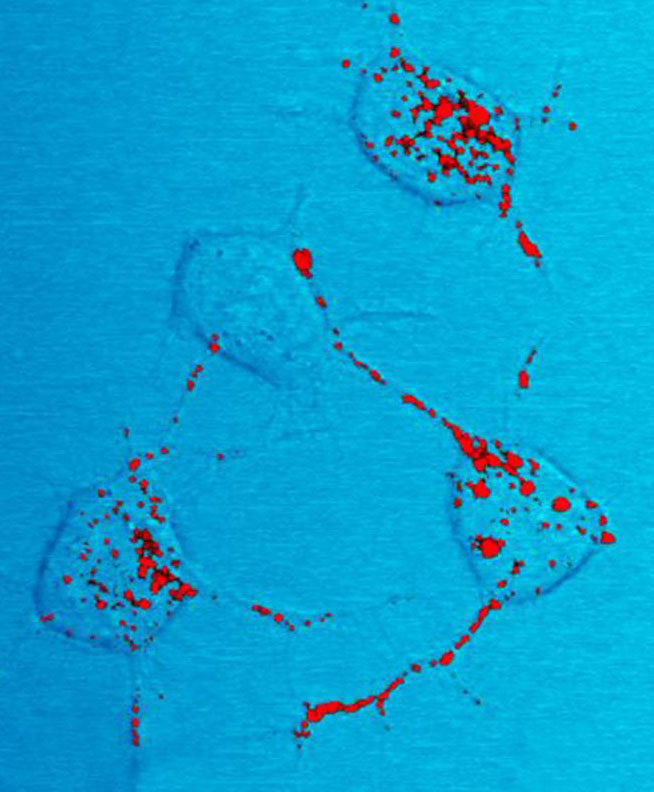
A neuron showing the presence of a prion protein (in red).
Photo Credit: NIAID
Image source: phil.cdc.gov
Most people had never heard much about prion diseases until “Mad cow disease” (bovine spongiform encephalopathy) made the news several years ago. When cows in the United Kingdom were found to be sick with the disease, the U.S. cut off purchasing beef from the U.K. as a precaution. The disease can be transmitted to people when they eat beef contaminated with the prion.
Since prions are neurodegenerative diseases, infected people experience muscular coordination problems, personality changes, impaired memory and thinking, and vision problems. They may eventually lose the ability to speak or move; coma can occur, leading to death.
Check Your Understanding
- Describe the structure of a virus.
- How does a virus cause disease in the human body?
- How does a virus multiply?
- Describe the structure of a prion.
- With respect to genetic composition, how are prions unlike any other type of infectious agent?

